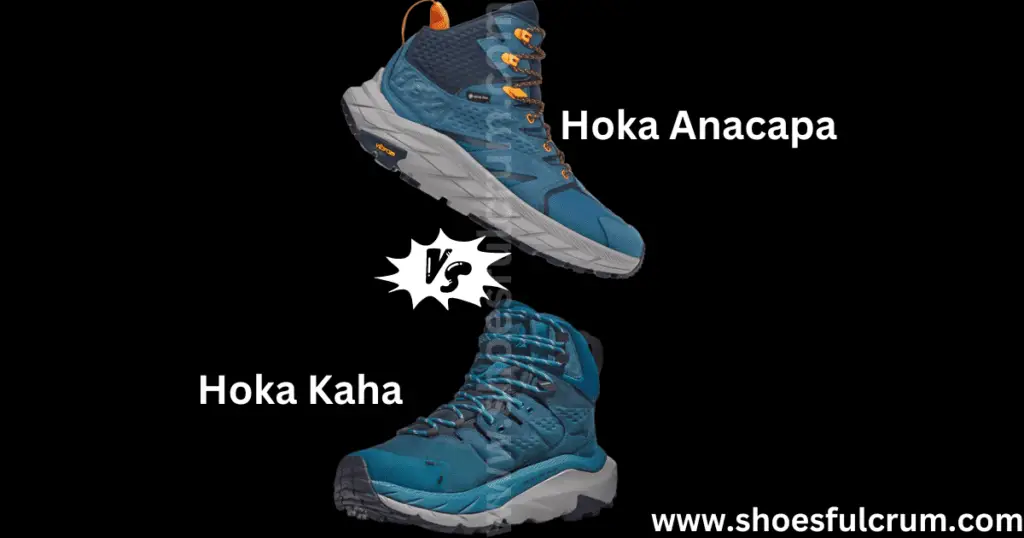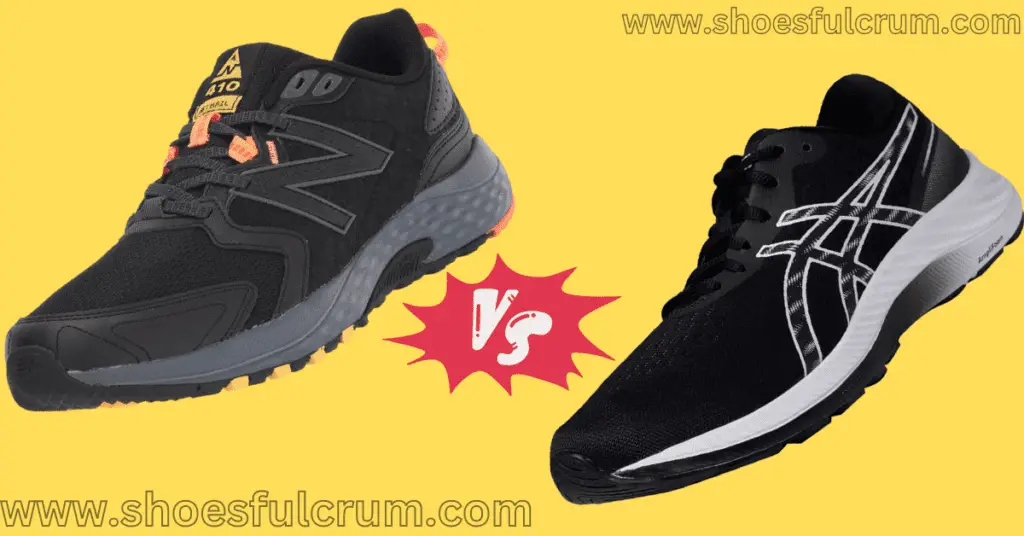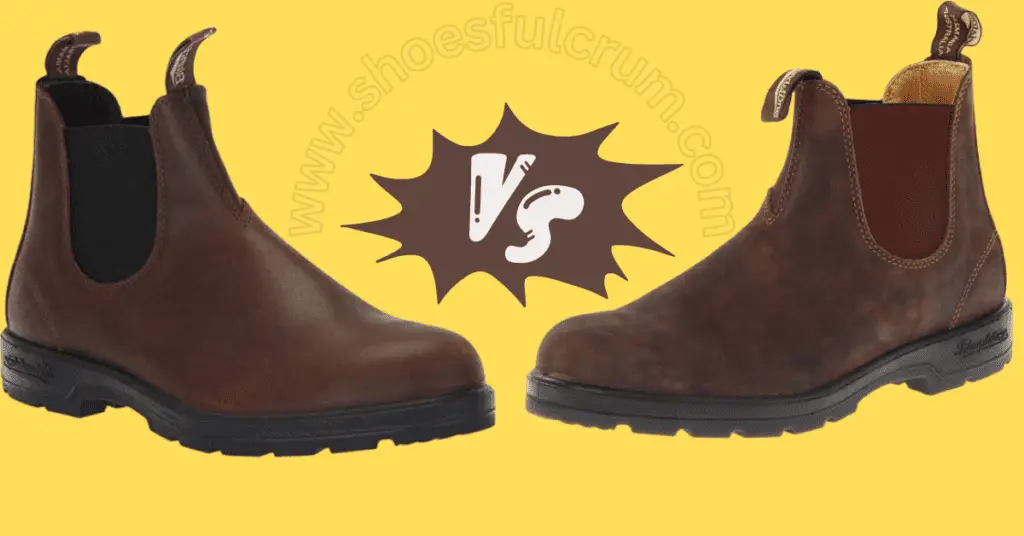If you also like trail running like me, you understand the struggle of finding the ideal pair of shoes for hitting the trails. I’m excited to share valuable insights on two popular brands: the Hoka Anacapa and Hoka Kaha trail running shoes.
Trail running is not just a pastime, it’s a lifestyle. There’s nothing quite like conquering challenging terrains and connecting with nature. However, without suitable footwear, our adventures can quickly turn into painful experiences. That’s why selecting the right trail running shoe is crucial.
Whether you’re a seasoned trail runner looking to upgrade your footwear or a beginner ready to explore this world of trail running, this article will guide you toward making an informed decision.
I also assure you that your feet will be supported, protected, and ready for any challenge that comes your way as we dive into the world of Hoka Anacapa and Kaha trail running shoes.
In this article, I’ll provide you with all the necessary details that will help you make an informed decision that aligns with your running style and preferences. So let’s lace up and hit those trails with confidence.
Major Differences Between Hoka Anacapa VS Kaha
| Criteria | Hoka Anacapa | Hoka Kaha | Real Winner |
|---|---|---|---|
| Fit and Comfort | Lightweight and responsive cushioning | Maximum cushioning and enhanced stability | Hoka Anacapa |
| Traction and Durability | Good traction, slightly less durable | Aggressive traction and durable construction | Hoka Kaha |
| Weight and Flexibility | Lightweight and flexible | Heavier weight, less flexibility | Hoka Anacapa |
| Breathability | Breathable upper construction | Waterproof upper for protection in wet conditions | Hoka Anacapa |
| Price and Value | Affordable price, good value for the features | Higher price offers value for advanced cushioning and durability | Hoka Anacapa |
| Style and Design | Sleek and modern design with vibrant color options | Rugged and utilitarian look | Tie |
| Suitable for | Well-maintained trails, speed-oriented runners | Challenging terrains, endurance runners | Hoka Kaha |
| Long-Distance Running | Suitable for long-distance running | The rugged and utilitarian look | Tie |
| Width Options | Available in different widths for various foot sizes | Available in different widths for various foot sizes | Tie |
When it comes to choosing the perfect trail shoes for your outdoor adventures, Hoka Anacapa and Kaha stand out as exceptional options. While both models belong to the renowned Hoka brand, they offer distinct features and cater to different needs.
Understanding the major differences between Hoka Anacapa and Kaha is crucial for selecting the ideal shoe that aligns with your trail running or hiking requirements.
1) Comfort And Fit
Starting with the fit, both the Hoka Anacapa and Kaha offer a roomy toe box, allowing your toes to splay naturally. This is a great feature, as it helps prevent discomfort and blisters, especially during long runs when your feet tend to swell.
However, there are some subtle differences in the overall fit of these shoes.
Hoka Anacapa
The Hoka Anacapa has a slightly snugger fit compared to the Kaha.
Its upper wraps around the foot securely, providing a supportive feel without compromising comfort. The lace-up system allows for customizable tightening so that you can achieve the desired fit based on your preferences.
With the Anacapa, you’ll experience a locked-in sensation that keeps your foot secure during technical trails.
Hoka Kaha
On the other hand, the Hoka Kaha offers a more generous fit.
It has a wider profile, providing more room for your foot to move and expand. This can be particularly beneficial if you have wider feet or if you prefer a more relaxed fit.
The Kaha’s lace-up system also allows for adjustments, ensuring a secure and personalized fit.
2) Cushioning And Support
Cushioning and Support are also important features to discuss when we talk about comfort and fit.
Hoka Anacapa
Let’s first discuss Hoka Anacapa which features Hoka’s signature maximalist cushioning, and provides a plush and comfortable ride.
The ample cushioning in the midsole helps absorb impact, reducing stress on your joints and muscles. This is particularly beneficial on rugged terrains where shock absorption is crucial for maintaining stability and preventing fatigue.
Hoka Kaha
In contrast, the Hoka Kaha takes cushioning to the next level.
It is designed with even more generous cushioning throughout the midsole, making it one of the most cushioned trails running shoes in Hoka’s lineup. The added cushioning offers exceptional underfoot protection and a cloud-like feel.
If you prioritize cushioning and desire an extra level of comfort, the Kaha might be the perfect choice for you.
Support
When it comes to SUPPORT, both shoes offer excellent stability on the trails.
Hoka Anacapa
The Anacapa features a reinforced toe cap and heel counter, providing added protection and stability in technical sections.
It ensures that your foot stays secure within the shoe, reducing the risk of injury and enhancing overall stability.
Hoka Kaha
Similarly, the Kaha incorporates sturdy overlays and a supportive heel counter to deliver reliable support.
These features contribute to a stable platform, allowing you to tackle uneven surfaces and descents with confidence. Whether you’re running on rocky trails or navigating steep inclines, the Kaha provides the support needed to maintain a steady stride.
Impact Of Fit And Comfort On Performance
Fit and comfort play a significant role in your trail running performance. Ill-fitting or uncomfortable shoes can hinder your stride, cause blisters, and even lead to injuries.
The Hoka Anacapa and Kaha prioritize fit and comfort, albeit with slight differences.
The Anacapa’s snug fit and secure feel lend themselves well to technical trails, providing a responsive and agile experience. The added cushioning ensures a comfortable ride, while the support features contribute to stability and confidence on challenging terrains.
On the other hand, the Kaha’s roomy fit and maximum cushioning excel in delivering a luxurious and comfortable running experience. If you prioritize long-distance comfort or have wider feet, the Kaha might be the better option. Its ample cushioning and supportive design help reduce fatigue, making it an excellent choice for endurance runners.
3) Traction And Durability
Let’s start with traction.
Hoka Anacapa
The Hoka Anacapa is equipped with an outsole that is designed to provide a reliable grip on a variety of surfaces.
It features multidirectional lugs strategically placed to ensure excellent traction on muddy trails, slippery rocks, and loose gravel.
The lugs penetrate the ground, offering stability and preventing any slippage during your runs. This level of traction allows you to confidently navigate challenging terrains without compromising your performance.
Hoka Kaha
On the other hand, the Hoka Kaha takes traction to another level.
Its outsole is specifically designed with Vibram Megagrip technology, which is known for its exceptional grip and traction on both wet and dry surfaces.
The multidirectional lugs on the Kaha are deeper and more aggressive, providing superior traction even on the most challenging trails.
Whether you’re running on steep inclines or unpredictable terrains, the Kaha’s outsole will keep you secure and confident every step of the way.
Durability
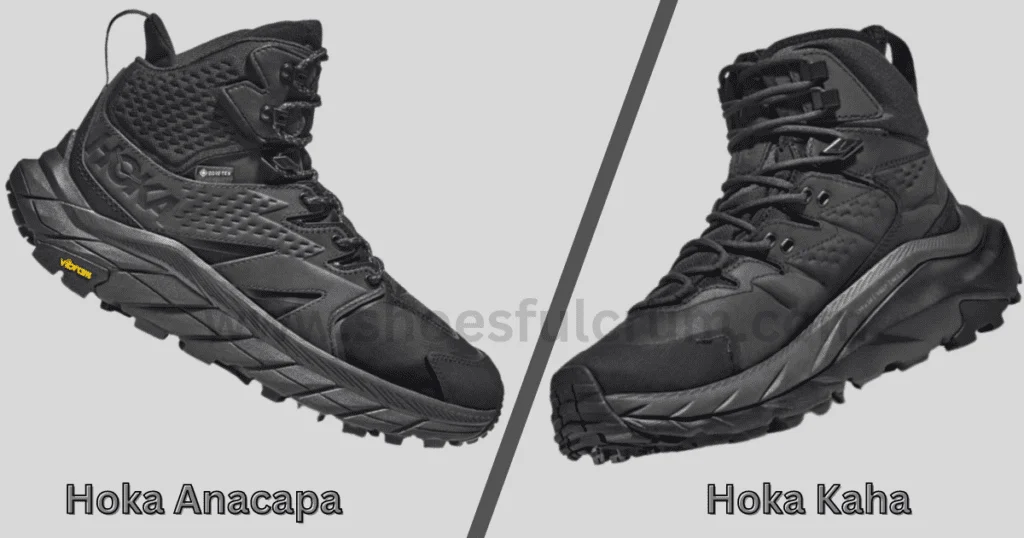
Now let’s talk about durability.
Both the Hoka Anacapa and the Hoka Kaha are built to withstand the demands of trail running, but they differ in their construction and materials.
Hoka Anacapa
The Anacapa features a combination of breathable mesh and synthetic materials in its upper, providing a balance between ventilation and protection.
The reinforced toe cap and heel counter add an extra layer of durability, shielding your feet from rocks and debris.
The outsole of the Anacapa is made of a durable rubber compound that can withstand the abrasive nature of trail surfaces. These features ensure that the Anacapa remains resilient even after many miles on the trails.
Hoka Kaha
The Kaha takes durability to another level.
Its upper is constructed using waterproof materials, providing additional protection against the elements and enhancing the overall longevity of the shoe. This makes the Kaha a great choice for runners who frequently encounter wet and muddy conditions.
The outsole of the Kaha is also made from a durable rubber compound, but with an added benefit of Vibram Megagrip technology, which further enhances its durability and longevity.
In terms of longevity, both shoes are designed to be durable and long-lasting.
However, the Kaha’s waterproof upper and enhanced outsole technology may give it a slight edge in terms of durability, especially for runners who face more extreme weather conditions or rugged terrains on a regular basis.
4) Weight And Flexibility
When it comes to trail running, having lightweight shoes can make a significant difference in your performance, especially during long-distance runs or when tackling technical terrains.
Hoka Anacapa
The Hoka Anacapa is designed with a focus on lightweight construction, allowing you to move more freely and effortlessly on the trails.
The midsole foam used in the Anacapa is specifically engineered to provide a balance between cushioning and weight, resulting in a shoe that feels surprisingly light on your feet.
This lightweight nature of the Anacapa helps you maintain your pace and conserve energy, ensuring a more enjoyable and efficient running experience.
Hoka Kaha
On the other hand, the Hoka Kaha is slightly heavier compared to the Anacapa.
The additional weight can be attributed to the shoe’s added features, such as increased cushioning and support. While this may sacrifice some of the lightweight advantages, the Kaha compensates with enhanced stability and protection.
The extra weight in the Kaha can be beneficial for runners who require more support, particularly on rough and challenging trails.
Flexibility
Moving on to flexibility, this aspect is crucial for trail running shoes as it allows for natural foot movement and adaptation to varying terrains.
Hoka Anacapa
The Hoka Anacapa strikes a good balance between flexibility and stability.
The midsole materials and design provide adequate flexibility, enabling your feet to move more naturally while maintaining the necessary support.
This flexibility enhances your agility on the trails, allowing for quick adjustments and smoother transitions.
With the Anacapa, you can confidently navigate uneven surfaces, tight turns, and obstacles without feeling restricted.
Hoka Kaha
In comparison, the Hoka Kaha offers a slightly stiffer and more supportive structure.
The increased cushioning and support in the midsole provide a stable and secure platform, which can be particularly beneficial for runners who prioritize protection and want a shoe that can handle rugged terrains with ease.
While the Kaha may sacrifice some flexibility, it offers a trade-off by providing added stability and a solid foundation for more demanding trail conditions.
Materials use
The materials used in the upper construction of both shoes also play a role in their flexibility.
Hoka Anacapa
The Hoka Anacapa incorporates a combination of breathable mesh and synthetic materials in its upper, allowing for a comfortable and flexible fit.
This blend of materials promotes ventilation and prevents the shoe from feeling rigid or constricting during your runs.
Hoka Kaha
On the other hand, the Hoka Kaha features a waterproof upper design that utilizes durable and supportive materials.
While the waterproof feature can be advantageous in wet conditions, it may slightly compromise the shoe’s overall flexibility.
However, the Kaha’s upper materials still offer a decent level of flexibility considering the shoe’s emphasis on protection and stability.
5) Breathability And Waterproofness
Breathability And Waterproofness are also important features to discuss when we search for differences between both shoes.
Hoka Anacapa
This shoe is designed with breathability in mind, utilizing a mesh upper material that allows for ample airflow. The mesh is strategically placed throughout the upper to promote ventilation and prevent excessive heat buildup.
This is particularly beneficial on long runs or in hot and humid conditions, as it helps to keep your feet cool and dry, reducing the risk of discomfort or blisters.
Hoka Kaha
On the other hand, the Hoka Kaha is engineered with a different focus on waterproofness.
The upper of the Kaha is constructed using waterproof materials that are designed to keep your feet dry in wet conditions.
Whether you’re running through puddles or encountering unexpected rain showers, the waterproof upper of the Kaha provides an extra layer of protection, preventing water from seeping into the shoe and keeping your feet dry.
Important Note:
While the Anacapa prioritizes breathability and the Kaha prioritizes waterproofness, it’s important to note that there may be a trade-off between the two.
The waterproof materials used in the Kaha’s upper can limit the shoe’s breathability to some extent. While it does offer some breathability, it may not match the same level as the Anacapa.
However, for those who frequently run in wet or rainy conditions, the waterproofness of the Kaha can be a game-changer, allowing you to keep running comfortably without worrying about soggy feet.
Importance Of Breathability And Waterproofness For Trail Running
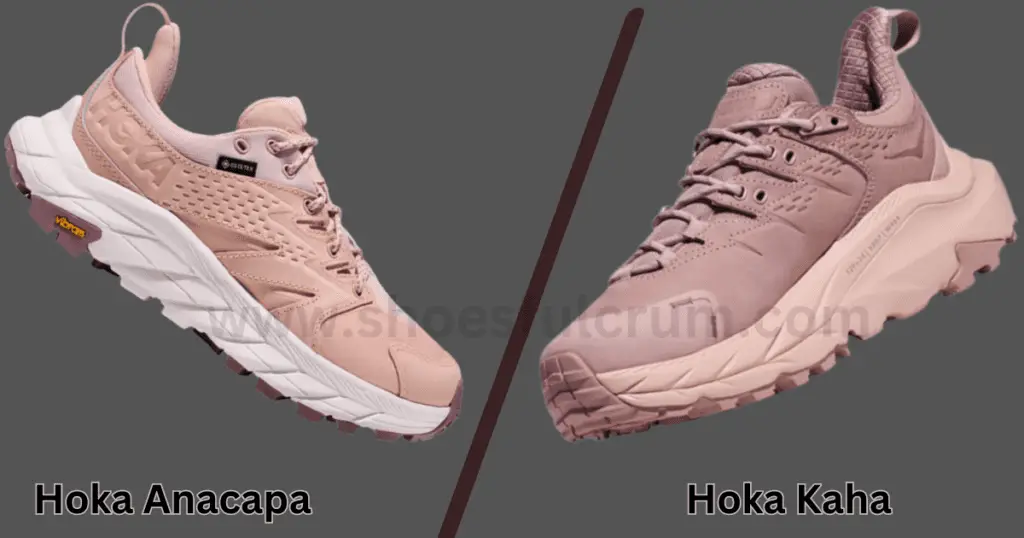
When it comes to trail running, both breathability and waterproofness play crucial roles in your overall comfort and performance.
Breathability helps to regulate the temperature inside the shoe, allowing excess heat and moisture to escape, thereby reducing the risk of discomfort, odor, and blisters.
On the other hand, waterproofness is particularly important when running in wet or muddy conditions. It keeps your feet dry and prevents water from saturating the shoe, which can add weight, cause discomfort, and increase the risk of blisters or fungal infections.
Ultimately, the choice between the Hoka Anacapa and the Hoka Kaha depends on your specific needs and the conditions you typically encounter during your trail runs.
Assess your running environment, climate, and personal preferences to determine which shoe will best suit your needs.
If breathability is your top priority, especially in warmer climates or on longer runs, the Anacapa may be the better option.
However, if you frequently run in wet or rainy conditions and require the added protection of a waterproof upper, the Kaha is worth considering.
6) Price And Value
In this section, we’ll take a look at the price and value of two popular trail running shoes from Hoka, the Anacapa, and the Kaha.
Hoka Anacapa
The Hoka Anacapa is generally priced in a more affordable range compared to the Kaha. This makes it a great option for trail runners who are looking for a reliable shoe without breaking the bank.
The Anacapa offers a range of features that make it a solid choice for both beginners and experienced runners, all at a relatively lower price point.
Hoka Kaha
On the other hand, the Hoka Kaha falls into a higher price category. The Kaha is a premium trail running shoe with advanced features and technologies that cater to the needs of serious trail runners.
The higher price tag reflects the added benefits and materials used in the shoe’s construction. While it may require a larger investment upfront, the Kaha offers excellent performance and durability, making it a worthwhile investment for dedicated trail runners.
7) Differences In Features And Benefits

In terms of features and benefits, both shoes have their unique advantages.
Hoka Anacapa
The Anacapa, despite its lower price, doesn’t compromise on quality. It offers a lightweight and breathable mesh upper, generous cushioning for comfort, reliable traction, and a roomy toe box.
These features provide a comfortable and enjoyable trail running experience, especially for those who prioritize breathability and versatility.
Hoka Kaha
On the other hand, the Kaha offers a more robust and durable construction. It features a waterproof upper that keeps your feet dry and protected in wet conditions, making it suitable for trail runners who frequently encounter rain or muddy terrain.
The Kaha also offers enhanced stability and support through its J-Frame design in the midsole. This added support can be particularly beneficial on technical and challenging trails.
Important Note:
When considering value, it’s important to assess not just the price, but also the overall performance and durability of the shoe.
While the Kaha comes at a higher cost, its advanced features and premium construction can deliver exceptional value for trail runners who require the added support and protection it offers.
On the other hand, the Anacapa provides excellent value for runners seeking a reliable and affordable option without compromising on quality.
Availability:
It’s worth noting that the availability of both shoes may vary depending on location and demand.
The Anacapa, being a popular and budget-friendly option, is often widely available in various retail outlets and online platforms.
The Kaha, with its premium features, may have more limited availability, especially in certain regions or during high-demand periods.
I always recommend checking with local retailers or trusted online sources for availability and pricing options.
8) Style And Design
When it comes to selecting a new pair of trail running shoes, the importance of style and design may vary from person to person. For some runners, having a shoe that not only performs well but also complements their personal style is crucial.
In this section, I’ll explore the differences in style and design between the Hoka Anacapa and Kaha trail running shoes.
One of the most noticeable distinctions between these two shoes is their color options.
Hoka Anacapa
The Hoka Anacapa offers a range of vibrant colors including blue, green, pink, and yellow
while the Kaha has a more subdued palette with options like black, gray, and navy. This could be a deciding factor for runners who prefer either an eye-catching or low-key shoe.
In terms of overall aesthetics, the Hoka Anacapa boasts a sleek and contemporary design with its breathable mesh construction and overlays for added support. The shoe’s side features prominent branding that adds both color and flair to its appearance.
Hoka Kaha
In contrast, the Kaha has a more rugged look with its waterproof synthetic material upper that includes protective toe caps. Its design prioritizes functionality over fashion.
Prioritization :
Although style and design may not be at the top of everyone’s list when purchasing trail running shoes, they can still play an important role in one’s buying decision.
For those who value both performance and aesthetics equally highly, the Hoka Anacapa might be their ideal choice due to its modern look along with bright color options that make it stand out on trails.
However, for those who prioritize durability as well as a function over fashion when choosing footwear for trail runs or hikes – Kaha’s utilitarian yet sturdy design might make it more appealing than other available options on the market today.
Hoka Anacapa VS Kaha: Who Should Choose What?
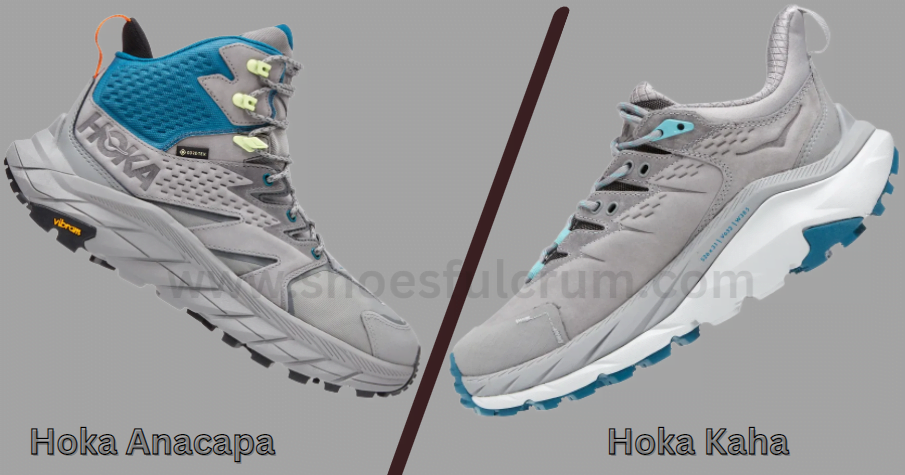
If you’re trying to decide between the Hoka Anacapa and Kaha trail running shoes, there are a few things to keep in mind to ensure you choose the best fit for your specific needs. Each shoe has its own distinct characteristics and advantages that cater to various types of runners and running environments.
Now I will tell you some key factors which you should keep in mind while making your decision.
Type Of Terrain And Running Conditions
Consider the type of terrain you’ll be running on. If you frequent rugged and technical trails with unpredictable weather conditions, the Hoka Kaha may be more suitable.
Its waterproof upper, durable construction, and aggressive outsole provide excellent protection and traction on challenging terrains.
On the other hand, if you primarily run on well-maintained trails and prioritize a lightweight and breathable shoe, the Hoka Anacapa would be a great choice.
Cushioning And Support Needs
Evaluate your cushioning and support requirements.
The Hoka Kaha offers maximum cushioning and enhanced stability, making it ideal for runners who require extra support, such as those with joint issues or a preference for a plush ride.
Conversely, the Anacapa provides a more responsive and lightweight feel, making it suitable for runners who prefer a more minimalistic and natural running experience.
Duration Of Runs
Consider the duration of your runs. If you often embark on longer runs or participate in ultramarathons, the additional cushioning and support of the Kaha may help reduce fatigue and provide long-lasting comfort.
However, if you typically run shorter distances or prioritize speed, the Anacapa’s lighter weight and more agile design can offer the responsiveness you need.
Individual Preferences And Needs
Think about your personal preferences and needs as a runner.
Do you prioritize style, color options, or a particular aesthetic? The Anacapa offers a range of vibrant colors and a sleek design, while the Kaha leans towards a more rugged and utilitarian appearance.
Additionally, consider factors like shoe width, toe box room, and arch support, as these can greatly impact your comfort and overall running experience.
Recommendations For Different Types Of Runners
Considering these factors which I have mentioned above, here are some recommendations based on different types of runners
Trail Running Enthusiasts
If you’re an avid trail runner who frequently tackles challenging terrains, varying weather conditions, and longer distances, the Hoka Kaha’s durability, waterproofness, and maximum cushioning make it an excellent choice to withstand the demands of your adventures.
Lightweight And Speed-Oriented Runners
For runners who prioritize speed, agility, and a more minimalistic shoe, the Hoka Anacapa’s lightweight design, responsive cushioning, and breathable upper provide the ideal balance of performance and comfort.
Versatile Trail Runners
If you’re looking for a versatile option that can handle a range of terrains and distances, the Hoka Anacapa offers a good compromise.
Its combination of lightweight design, decent cushioning, and breathability makes it suitable for various running conditions.
Pros And Cons
Hoka Anacapa
| Pros | Cons |
|---|---|
| Lightweight | Limited color options |
| Responsive cushioning | Less cushioning |
| Breathable | Not suitable for rugged terrains |
| Versatile | |
| Good traction | |
| Affordable price | |
| Stylish design |
Hoka Kaha
| Pros | Cons |
|---|---|
| Maximum cushioning | Higher price |
| Excellent support | Heavier weight |
| Waterproof | Limited color options |
| Durable construction | |
| Aggressive traction | |
| Ideal for long distances | |
| Protection for rugged terrains |
Conclusion
I hope you will be now much more familiar with Hoka Anacapa VS Kaha, moreover, the choice between the Hoka Anacapa and Kaha comes down to your own preferences and running requirements.
If you value lightweight agility and breathability, the Anacapa is the winner. However, if you prioritize maximum cushioning, durability, and traction, the Kaha takes the lead.
It’s important to try on both shoes and consider factors such as fit, comfort, terrain, and personal preferences before making a final decision. Additionally, customer feedback and reviews can offer valuable insights into the experiences of other runners.
Remember, the best shoe for you is the one that aligns with your unique running style, goals, and comfort. So, lace up, hit the trails, and enjoy your running journey with the Hoka Anacapa or Kaha, knowing that you’ve made a well-informed choice based on your individual needs.
Happy trails!
Frequently Asked Questions
Are the Hoka Anacapa and Kaha trail running shoes?
Yes, both the Hoka Anacapa and Kaha are specifically built for trail running and have features that improve performance on a variety of terrains.
Is the Hoka Anacapa and Kaha water resistant?
The Hoka Kaha is waterproof, making it suitable for rainy and muddy circumstances. While, the Hoka Anacapa, is not waterproof but is quite breathable.
Are the Hoka Anacapa and Kaha long-distance running shoes?
Yes, the Anacapa and Kaha are both appropriate for long-distance running. The Kaha is a popular choice for endurance runners due to its excellent cushioning and stability.
Can the Hoka Anacapa and Kaha be used on rough terrain?
Yes, the Hoka Kaha’s sturdy structure and powerful traction make it ideal for rough terrain. The Anacapa is also acceptable, however, it may not be as long-lasting.
Are the Hoka Anacapa and Kaha available in a variety of widths?
Both the Anacapa and Kaha are available in a variety of widths to fit different foot sizes and preferences.
Can runners with wide feet wear the Hoka Anacapa and Kaha?
Both the Anacapa and the Kaha are available in bigger widths, making them appropriate for runners with wider feet.
Can I hike or conduct other outdoor activities with the Hoka Anacapa and Kaha?
While the Hoka Anacapa and Kaha are primarily built for trail running, they may also be used for hiking and other outdoor sports that demand grip, durability, and protection.
How should I clean my Hoka Anacapa and Kaha?
For both shoes, it is best to follow the manufacturer’s cleaning guidelines. Wiping the shoes with a moist cloth and mild soap should usually suffice.
How long do Hoka Anacapa and Kaha last on average?
The longevity of the shoes is determined by a number of factors, including frequency and intensity of use, terrain, and individual running style. Both shoes can last several hundred kilometers on average.

About Author:
Hammad Qadir is a passionate fashion blogger with a passion for shoes, spanning over seven years. As the driving force behind “ShoesFulcrum.com” he offers unparalleled insights into iconic brands like Crocs, Hey Dude, and Birkenstock. With a collection of a hundred pairs, his expertise extends to industry giants like Nike and Adidas. Through insightful reviews and recommendations, Hammad guides readers to their perfect pair. Hammad’s knack for differentiating between brands and guiding readers makes him a trusted authority. Active on Quora, Reddit, Medium, LinkedIn, and Pinterest, he fosters engagement and shares exclusive content. Read more...

